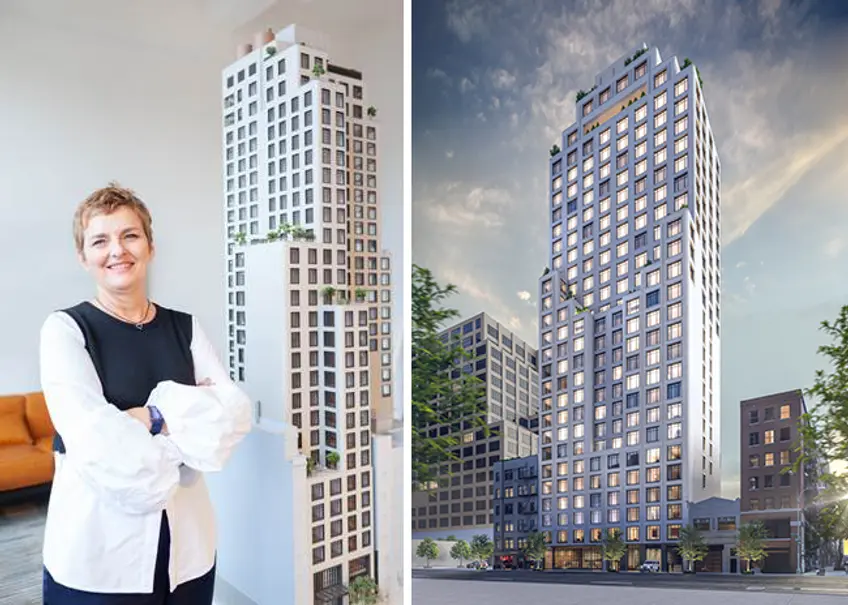 Francoise Raynaud (l) in sales gallery of Greenwich West (r; all images via Loci Anima)
Francoise Raynaud (l) in sales gallery of Greenwich West (r; all images via Loci Anima)
All New York neighborhoods change over time, but Hudson Square has perhaps shown one of the more dramatic evolutions. The former industrial printing district is preparing to welcome Google, and acclaimed architects have been tapped to meet growing housing demand in this west Soho neighborhood. One of them was the Paris-based Loci Anima, which made its American debut with Greenwich West, a 27-story tower that masterfully combines 20th-century French design with classic New York influences.
Loci Anima founder Francoise Raynaud worked alongside Pritzer Prize laureate Jean Nouvel for nearly two decades, and Greenwich West shows her signature approach to architecture as a living organism rather than a static force. CityRealty spoke to Ms. Raynaud about the inspirations behind Greenwich West, the challenges of building in a newly zoned New York neighborhood, and what the phrase "sustainable building" means to her.
Loci Anima founder Francoise Raynaud worked alongside Pritzer Prize laureate Jean Nouvel for nearly two decades, and Greenwich West shows her signature approach to architecture as a living organism rather than a static force. CityRealty spoke to Ms. Raynaud about the inspirations behind Greenwich West, the challenges of building in a newly zoned New York neighborhood, and what the phrase "sustainable building" means to her.
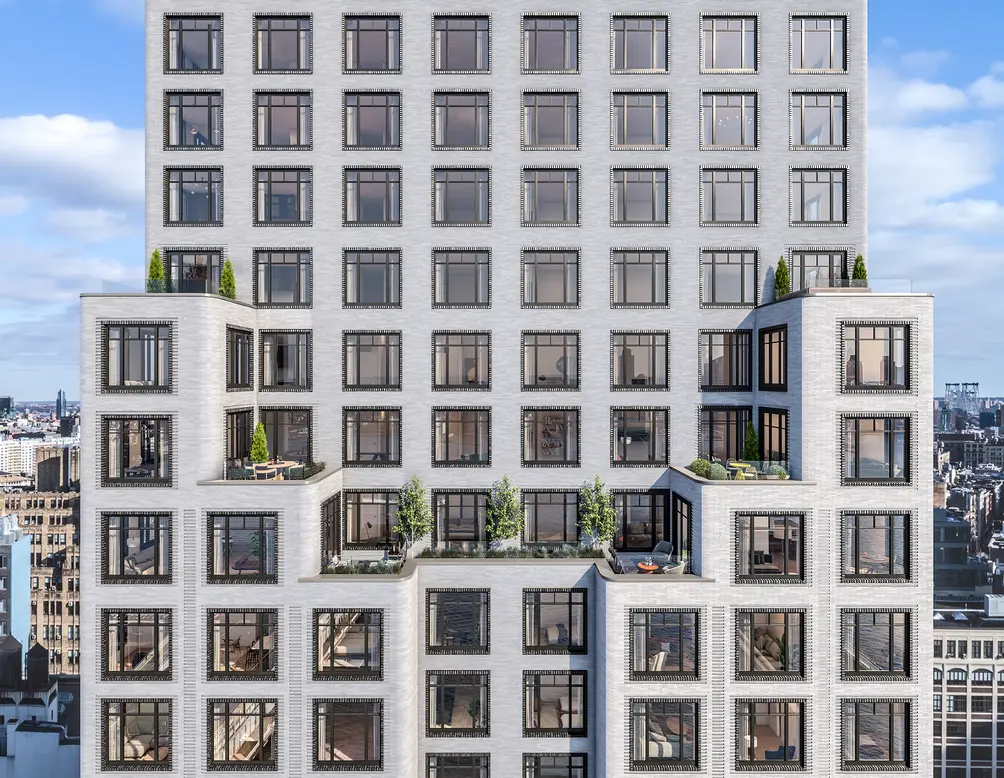 Facade details
Facade details
In this article:
What were the biggest inspirations for Greenwich West?
Few parts of Manhattan have such a visible urban history, so its influence on the context of the built environment is fundamental. The building is a reflection of the way that the Hudson Square district has evolved over the centuries, adapting itself to the changing social and urban context that has formed the area. Greenwich West is a contemporary insertion in this changing context that seats itself in a complex urban environment seeking stability and innovation.
The project sets out to be of outstanding architectural rigour and proportion, and to have an intrinsic site relationship. An adaptative contextual building, the visual impact of Greenwich West draws its essence not only from the industrial nature of the district, but the urban frame of the city. The assumed regularity of the window bays, that neutralize any notion of front or back to the building, are a typically industrial and New York language.
Few parts of Manhattan have such a visible urban history, so its influence on the context of the built environment is fundamental. The building is a reflection of the way that the Hudson Square district has evolved over the centuries, adapting itself to the changing social and urban context that has formed the area. Greenwich West is a contemporary insertion in this changing context that seats itself in a complex urban environment seeking stability and innovation.
The project sets out to be of outstanding architectural rigour and proportion, and to have an intrinsic site relationship. An adaptative contextual building, the visual impact of Greenwich West draws its essence not only from the industrial nature of the district, but the urban frame of the city. The assumed regularity of the window bays, that neutralize any notion of front or back to the building, are a typically industrial and New York language.
Nature is also present in the materiality of Greenwich West’s facades. Natural and noble materials are present throughout its design, no more so than the clay brick of the facades. Natural, durable, and reusable brick has undeniable sustainable qualities. In the Greenwich West building, a conscious decision was made for a material that stands for timelessness, sustainability and structural precision. The entire outer shell of the façade uses one material. The colour of white clay was chosen to create facing bricks of a clear light sandy grey nature, cut to measure and elongated to obtain a denser stratification that brings to mind the particular brightness of the Hudson sands. The brick texture and face structure together with the coursing creates a horizontal natural mineral stratification.
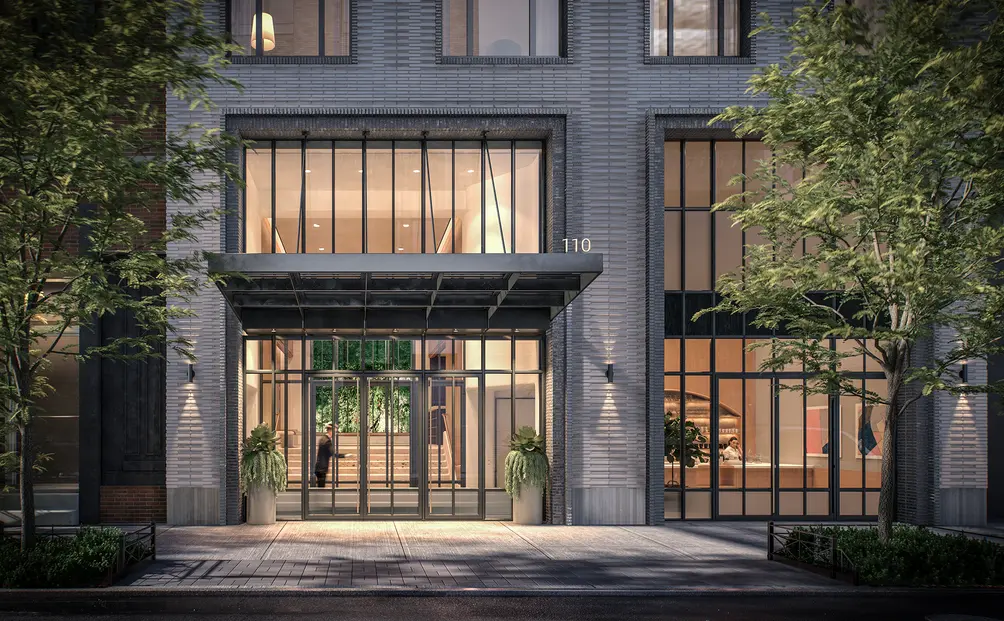 Building entrance
Building entrance
The window surrounds have uniquely designed ceramic finishes in contrast to the matte façade. The facing brick is a light sandy grey, chosen to soften the light, whereas the glazed brick window surrounds are dark shiny pewter finish, not dissimilar to that of printing casts that will reflect and enhance the sunlight, are of exceptional preciousness and refinement. They reflect the water of the Hudson, inscribing the tower in its environment. Like large reflectors, they help bring natural light into the apartments and reflect the first and last rays of the sun.
In contrast with the rugged firmness of the brick face, the squircle corners capture light, highlight and characterise the building in a singular manner. The rounded corners typify Greenwich West giving its mass a softer and subtle nature as if the corners have been rubbed out.
You have a sort of scarification on the building that typifies it. We want the building to be fully integrated into this New York spirit, but at the same time it had to be recognizable and refined, that it is invented in terms of style, a style that is a little French by this refinement.
You have a sort of scarification on the building that typifies it. We want the building to be fully integrated into this New York spirit, but at the same time it had to be recognizable and refined, that it is invented in terms of style, a style that is a little French by this refinement.
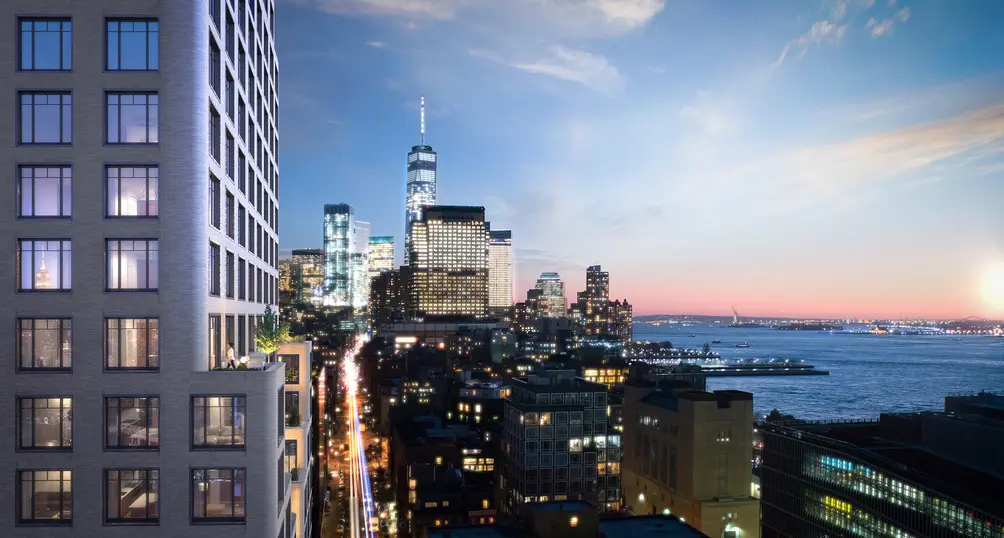 Greenwich West crown
Greenwich West crown
How does it feel to be a part of a rapidly evolving and rising neighborhood like Hudson Square?
When we started the project, Hudson Square had just had its zoning laws changed so that building heights were changed, and residential buildings would be allowed.
The zoning laws remained very complicated due to the tangram nature of the site sitting on two streets, having to take into account light and air rights that often contradict each other. The volume of the building is an extrapolation and optimization of space taking into account all the possible square footage available.
But it seemed to us that the question asked by our client – the reinterpretation of the New York tower in Hudson Square, an old printing district -‐ was extremely interesting.
When we started the project, Hudson Square had just had its zoning laws changed so that building heights were changed, and residential buildings would be allowed.
The zoning laws remained very complicated due to the tangram nature of the site sitting on two streets, having to take into account light and air rights that often contradict each other. The volume of the building is an extrapolation and optimization of space taking into account all the possible square footage available.
But it seemed to us that the question asked by our client – the reinterpretation of the New York tower in Hudson Square, an old printing district -‐ was extremely interesting.
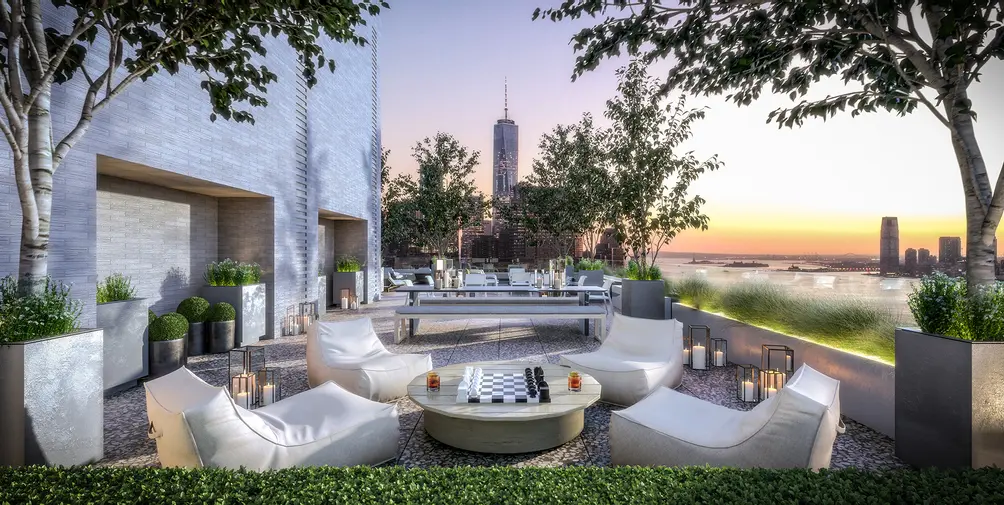 Roof terrace
Roof terrace
The danger of rapid redevelopment, when a district is renewed and the “world companies” move in, is for a globalization like every city in the world, cities all tend to look alike. They erase their cultural specificities.
It is important to think of the city of tomorrow no longer as a collection of architectural objects that fall from the sky (above ground), but as a kind of urban continuity in space and time to the benefit of the specificity of cities and districts.
It is important to think of the city of tomorrow no longer as a collection of architectural objects that fall from the sky (above ground), but as a kind of urban continuity in space and time to the benefit of the specificity of cities and districts.
We wanted to keep the window frame that is the beauty of New York, from the origins and is still very present in the district. We wanted to make a building that was both very classic and very chic. It's like a tailored Chanel in that regard: extremely classic, extremely timeless, but very beautiful in style. As Coco Chanel herself said, "Fashion fades, only style remains the same."
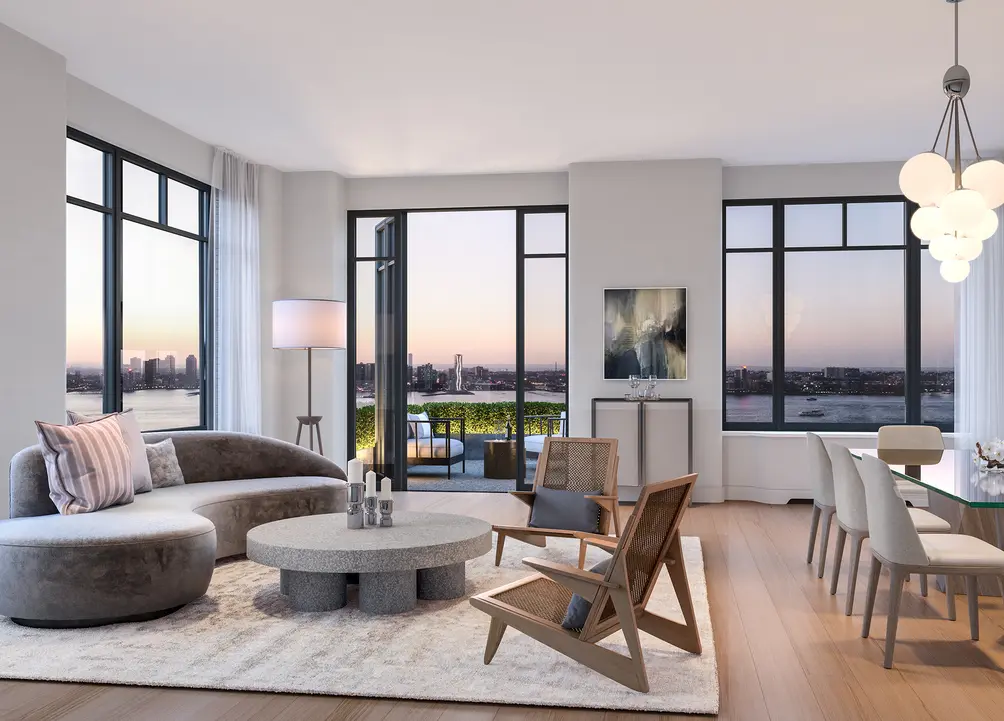 Living room
Living room
Following Loci Anima’s debut at Greenwich West, are there other New York neighborhoods you’d be interested in building in?
Every part of Manhattan would be a pleasure to work in, as the city is such a vibrant place to work in! But each Manhattan district has its own zoning and planning particularities, which offer different constraints to the architect, be it a super-skinny building on Central Park, an iconic cinema or theatre on Broadway, or a floating tower on the Hudson. New York always offers a challenge and an opportunity to innovate.
But as an architect, it’s not just the place, it’s the people that count in order to make a building. A successful building, particularly a residential, is first a building that is designed from inside but that does not necessarily show too much domesticity outside.
Every part of Manhattan would be a pleasure to work in, as the city is such a vibrant place to work in! But each Manhattan district has its own zoning and planning particularities, which offer different constraints to the architect, be it a super-skinny building on Central Park, an iconic cinema or theatre on Broadway, or a floating tower on the Hudson. New York always offers a challenge and an opportunity to innovate.
But as an architect, it’s not just the place, it’s the people that count in order to make a building. A successful building, particularly a residential, is first a building that is designed from inside but that does not necessarily show too much domesticity outside.
What were some of the biggest challenges of Greenwich West?
To conceive this building, it was necessary to play with and exploit the zoning rules to the max. This was a demanding job to keep the geometry extremely regular. It was not easy to understand, it is very complicated, but it was essential that we manipulate all these regulations to be able to exploit them to the best and to make the best for housing in terms of view, in terms of sun, in terms of double exposure, and in terms of fluidity of space.
It is like watchmaking that has allowed us to have so much quality housing in a volume constrained by urban planning rules. What is the most difficult in architecture and to create simplicity.
To conceive this building, it was necessary to play with and exploit the zoning rules to the max. This was a demanding job to keep the geometry extremely regular. It was not easy to understand, it is very complicated, but it was essential that we manipulate all these regulations to be able to exploit them to the best and to make the best for housing in terms of view, in terms of sun, in terms of double exposure, and in terms of fluidity of space.
It is like watchmaking that has allowed us to have so much quality housing in a volume constrained by urban planning rules. What is the most difficult in architecture and to create simplicity.
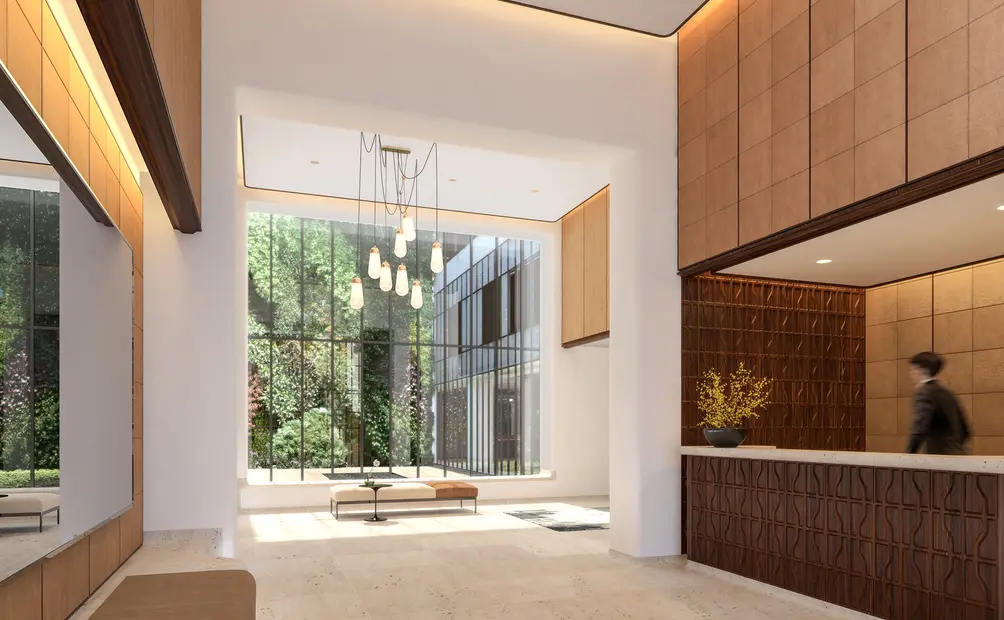 Lobby and vertical garden
Lobby and vertical garden
Between the Green New Deal and New York’s new emission caps, what do you see as the biggest challenges for sustainable building?
New York is starting to make moves in the right direction, but it’s far behind France and Europe as a whole. In France, building law has changed how we design and build buildings, along with financial incentives which give real leverage for investors. Over the past twenty years, progressive amendments to building regulation mean that we will soon only be able to build energy positive buildings.
New York is starting to make moves in the right direction, but it’s far behind France and Europe as a whole. In France, building law has changed how we design and build buildings, along with financial incentives which give real leverage for investors. Over the past twenty years, progressive amendments to building regulation mean that we will soon only be able to build energy positive buildings.
But this is only one aspect of building sustainability. We also have to think about waste disposal and our overall relationship with the environment. While we are recycling more and more, the real crux of the matter is not to create waste in the first place, beginning with reducing packaging and consuming less.
We should take a lesson from nature on this point -‐ nature does not produce more than it needs, and by products are reused in its natural processes. Nature is a very efficient and economic system.
So the real challenge today is to question our relationship with nature, since we’re part of that process. We have to respect it. For me, it’s the end of the architectural gesture. We need less domination, reflect with common sense, modesty and empathy to this immense challenge.
We should take a lesson from nature on this point -‐ nature does not produce more than it needs, and by products are reused in its natural processes. Nature is a very efficient and economic system.
So the real challenge today is to question our relationship with nature, since we’re part of that process. We have to respect it. For me, it’s the end of the architectural gesture. We need less domination, reflect with common sense, modesty and empathy to this immense challenge.
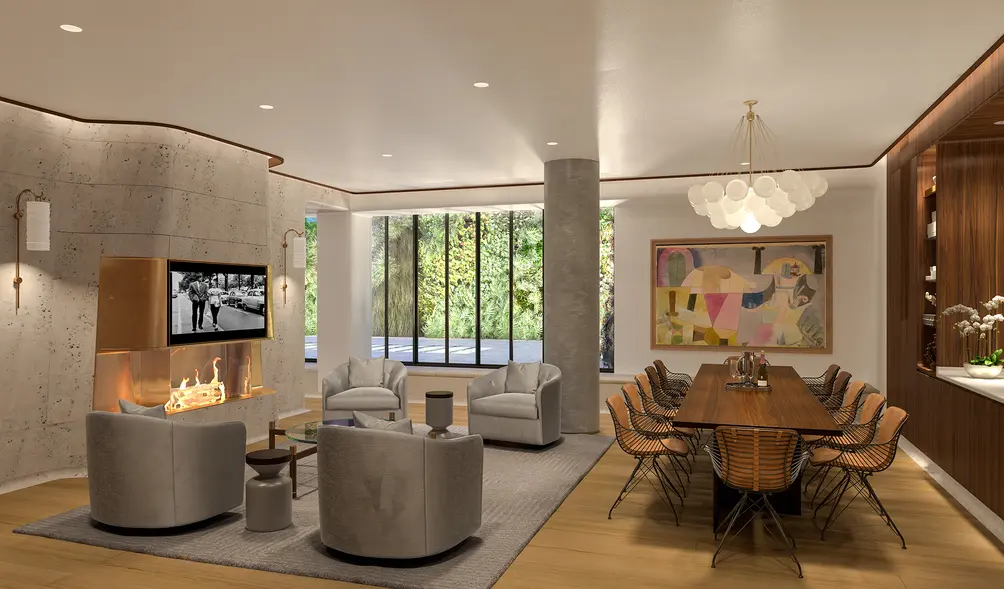 Lounge with courtyard access
Lounge with courtyard access
How does Loci Anima define "sustainable building"?
Use the least amount of land to build a building. That is, firstly we start using less land for our habitat – even for the biggest of our cities, or most difficult programs, we have to find innovative solutions.
Reconnect with nature and elements. For us, people must be connected to nature, to the sky, to the elements, to the sun, even in a building. These are outdoor spaces that extend the interior and allow man to be connected with his environment.
Use the least amount of land to build a building. That is, firstly we start using less land for our habitat – even for the biggest of our cities, or most difficult programs, we have to find innovative solutions.
Reconnect with nature and elements. For us, people must be connected to nature, to the sky, to the elements, to the sun, even in a building. These are outdoor spaces that extend the interior and allow man to be connected with his environment.
Reintroduce biodiversity into the city, and reconnect with the animal and plant world. We need to incorporate habitats for plant and especially animal life -- keeping the biodiversity healthy is a key to our own existence.
Be inspired by nature -‐ Nature doesn’t waste anything. Everything gets reused and is transformed into another form. Nature is very good at sustainability, as it produces nothing that it can’t reuse in its system. It means as well reusing materials and reusing space.
Be inspired by nature -‐ Nature doesn’t waste anything. Everything gets reused and is transformed into another form. Nature is very good at sustainability, as it produces nothing that it can’t reuse in its system. It means as well reusing materials and reusing space.
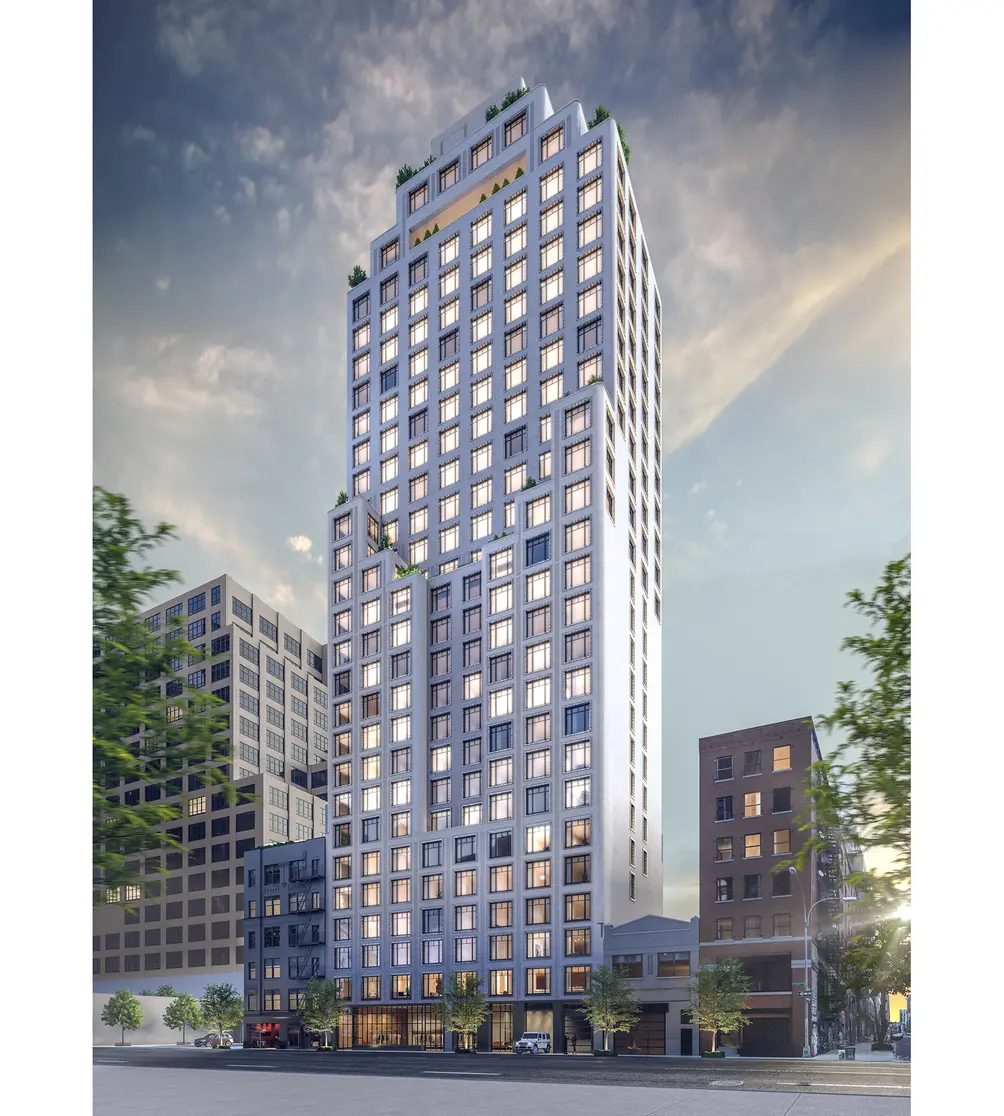 Greenwich West
Greenwich West
Would you like to tour any of these properties?

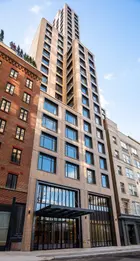
 6sqft delivers the latest on real estate, architecture, and design, straight from New York City.
6sqft delivers the latest on real estate, architecture, and design, straight from New York City.
